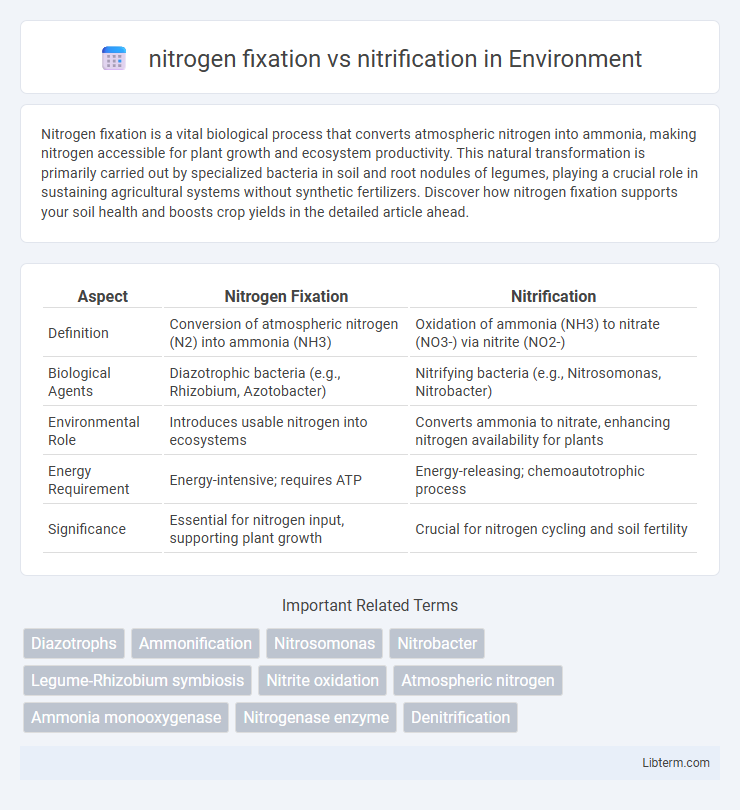Nitrogen fixation is a vital biological process that converts atmospheric nitrogen into ammonia, making nitrogen accessible for plant growth and ecosystem productivity. This natural transformation is primarily carried out by specialized bacteria in soil and root nodules of legumes, playing a crucial role in sustaining agricultural systems without synthetic fertilizers. Discover how nitrogen fixation supports your soil health and boosts crop yields in the detailed article ahead.
Table of Comparison
| Aspect | Nitrogen Fixation | Nitrification |
|---|---|---|
| Definition | Conversion of atmospheric nitrogen (N2) into ammonia (NH3) | Oxidation of ammonia (NH3) to nitrate (NO3-) via nitrite (NO2-) |
| Biological Agents | Diazotrophic bacteria (e.g., Rhizobium, Azotobacter) | Nitrifying bacteria (e.g., Nitrosomonas, Nitrobacter) |
| Environmental Role | Introduces usable nitrogen into ecosystems | Converts ammonia to nitrate, enhancing nitrogen availability for plants |
| Energy Requirement | Energy-intensive; requires ATP | Energy-releasing; chemoautotrophic process |
| Significance | Essential for nitrogen input, supporting plant growth | Crucial for nitrogen cycling and soil fertility |
Introduction to Nitrogen Fixation and Nitrification
Nitrogen fixation is the biological process where atmospheric nitrogen (N2) is converted into ammonia (NH3) by diazotrophic bacteria, making nitrogen accessible for plant uptake and essential for protein synthesis. Nitrification is the microbial oxidation of ammonia to nitrites (NO2-) and then to nitrates (NO3-), primarily carried out by autotrophic bacteria such as Nitrosomonas and Nitrobacter, which enrich soil nitrogen availability for plants. Both processes are critical components of the nitrogen cycle, influencing soil fertility, crop yield, and ecosystem productivity.
Overview of the Nitrogen Cycle
Nitrogen fixation converts atmospheric nitrogen (N2) into ammonia (NH3), making nitrogen accessible to plants and supporting primary productivity in ecosystems. Nitrification is a two-step microbial process that oxidizes ammonia to nitrite (NO2-) and then to nitrate (NO3-), which plants readily absorb for growth. Both processes are critical components of the nitrogen cycle, facilitating the transformation of nitrogen into biologically usable forms and maintaining soil fertility.
What is Nitrogen Fixation?
Nitrogen fixation is the biological process where atmospheric nitrogen (N2) is converted into ammonia (NH3), making nitrogen accessible to plants for growth. This critical step is primarily carried out by symbiotic bacteria such as Rhizobium species found in legume root nodules and free-living bacteria like Azotobacter. Nitrogen fixation supplies essential nitrogen compounds that fuel protein synthesis and other vital cellular functions in ecosystems.
Key Processes Involved in Nitrogen Fixation
Nitrogen fixation involves converting atmospheric nitrogen (N2) into ammonia (NH3) by nitrogenase enzymes present in diazotrophic bacteria and cyanobacteria, enabling plants to access usable nitrogen. This biochemical process requires ATP and electrons to break the strong triple bond of N2 molecules, forming ammonium ions incorporated into organic compounds. In contrast, nitrification is the microbial oxidation of ammonia to nitrite and then nitrate, primarily carried out by Nitrosomonas and Nitrobacter species, playing a distinct role in the nitrogen cycle.
What is Nitrification?
Nitrification is a crucial microbial process in the nitrogen cycle where ammonia (NH3) is oxidized into nitrites (NO2-) by ammonia-oxidizing bacteria, and then further converted into nitrates (NO3-) by nitrite-oxidizing bacteria. This aerobic process enhances soil fertility by transforming nitrogen into forms readily absorbed by plants, promoting growth and agricultural productivity. Unlike nitrogen fixation, which converts atmospheric nitrogen (N2) into ammonia, nitrification involves the oxidation of existing nitrogen compounds in the soil.
Steps and Microorganisms in Nitrification
Nitrification is a two-step aerobic process where ammonia-oxidizing bacteria (AOB), such as Nitrosomonas, oxidize ammonia (NH3) to nitrite (NO2-), followed by nitrite-oxidizing bacteria (NOB), like Nitrobacter, converting nitrite to nitrate (NO3-). This biochemical pathway is critical for nitrogen cycling in soil and aquatic ecosystems, enabling plants to assimilate nitrogen effectively. Unlike nitrogen fixation, which involves nitrogen-fixing bacteria (e.g., Rhizobium) converting atmospheric nitrogen (N2) into ammonia, nitrification relies on specific chemolithoautotrophic microbes that derive energy from oxidizing inorganic nitrogen compounds.
Differences Between Nitrogen Fixation and Nitrification
Nitrogen fixation converts atmospheric nitrogen (N2) into ammonia (NH3), making nitrogen accessible to plants, primarily through biological processes performed by bacteria such as Rhizobium and cyanobacteria. Nitrification is a two-step aerobic process where ammonia is oxidized first to nitrite (NO2-) by bacteria like Nitrosomonas, then nitrite is further oxidized to nitrate (NO3-) by Nitrobacter species, which plants assimilate. The key difference lies in nitrogen fixation introducing usable nitrogen into the ecosystem, while nitrification transforms ammonia into nitrate, enhancing nitrogen availability in a different chemical form.
Environmental Significance of Both Processes
Nitrogen fixation converts atmospheric nitrogen (N2) into ammonia, making nitrogen accessible to plants and enhancing soil fertility, thus supporting ecosystem productivity. Nitrification oxidizes ammonia into nitrate, which plants can readily absorb, but this process also contributes to soil acidification and can lead to nitrate leaching, impacting water quality. Both processes are critical components of the nitrogen cycle, influencing nutrient availability, greenhouse gas emissions, and overall environmental health.
Human Impact on Nitrogen Fixation and Nitrification
Human activities have significantly altered nitrogen fixation and nitrification processes through extensive use of synthetic fertilizers and industrial emissions. The widespread application of nitrogen-based fertilizers increases biologically available nitrogen, disrupting natural nitrogen fixation cycles and enhancing nitrification rates, which can lead to soil acidification and water pollution. Industrial pollution, such as nitrogen oxides released from fossil fuel combustion, further accelerates nitrification in ecosystems, contributing to nutrient imbalances and greenhouse gas emissions.
Conclusion: Nitrogen Fixation vs Nitrification in Ecosystem Health
Nitrogen fixation and nitrification play distinct but complementary roles in ecosystem health by maintaining nitrogen availability and soil fertility. Nitrogen fixation converts atmospheric nitrogen into forms usable by plants, fueling primary production, while nitrification transforms ammonia into nitrate, promoting nutrient cycling and supporting microbial activity. Together, these processes sustain ecosystem productivity, regulate nitrogen balance, and prevent nutrient imbalances that can lead to environmental degradation.
nitrogen fixation Infographic

 libterm.com
libterm.com